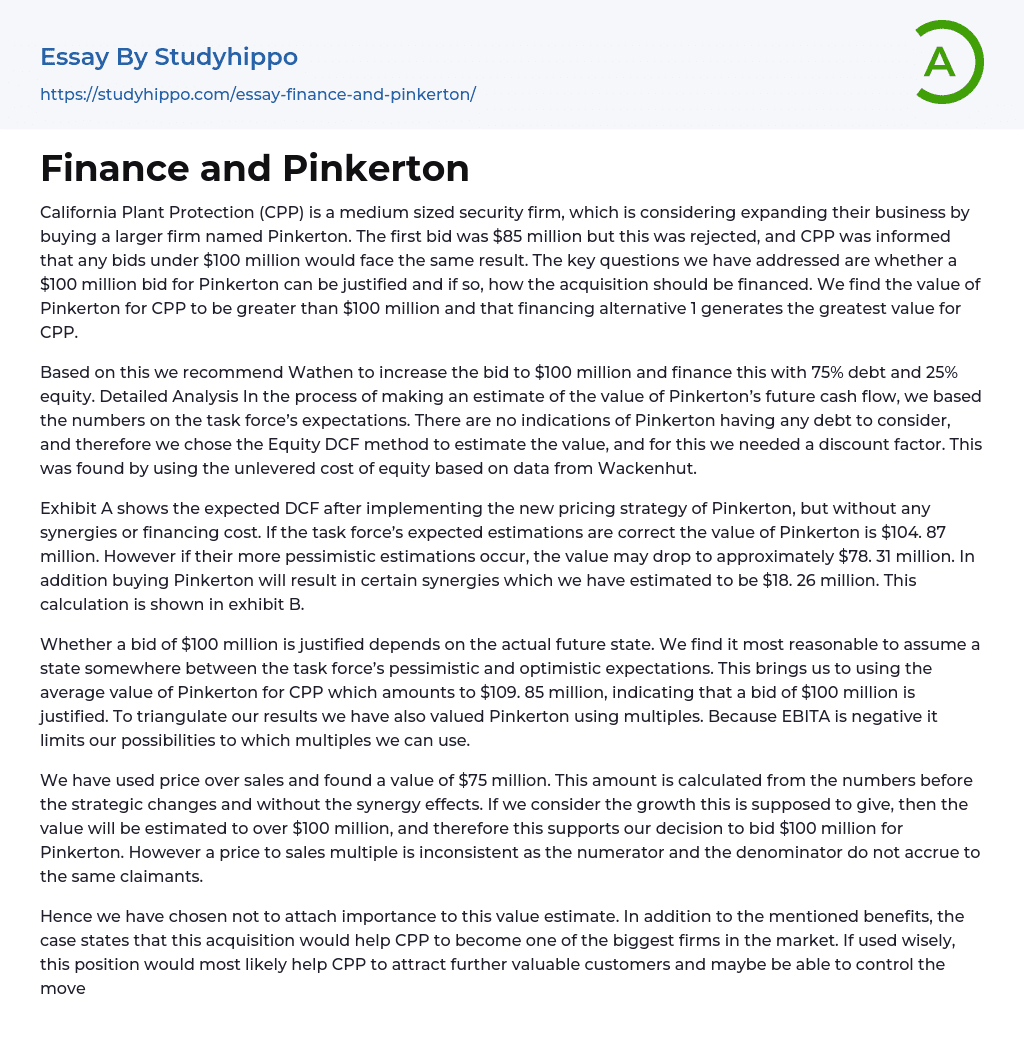Based on this we recommend Wathen to increase the bid to $100 million and finance this with 75% debt and 25% equity. Detailed Analysis In the process of making an estimate of the value of Pinkerton’s future cash flow, we based
...the numbers on the task force’s expectations. There are no indications of Pinkerton having any debt to consider, and therefore we chose the Equity DCF method to estimate the value, and for this we needed a discount factor. This was found by using the unlevered cost of equity based on data from Wackenhut.
Exhibit A shows the expected DCF after implementing the new pricing strategy of Pinkerton, but without any synergies or financing cost. If the task force’s expected estimations are correct the value of Pinkerton is $104. 87 million. However if their more pessimistic estimations occur, the value may drop to approximately $78. 31 million. In addition buying Pinkerton will result in certain synergies which we have estimated to be $18. 26 million. This calculation is shown in exhibit B.
Whether a bid of $100 millio
is justified depends on the actual future state. We find it most reasonable to assume a state somewhere between the task force’s pessimistic and optimistic expectations. This brings us to using the average value of Pinkerton for CPP which amounts to $109. 85 million, indicating that a bid of $100 million is justified. To triangulate our results we have also valued Pinkerton using multiples. Because EBITA is negative it limits our possibilities to which multiples we can use.
We have used price over sales and found a value of $75 million. This amount is calculated from the numbers before the strategic changes and without the synergy effects. If we consider the growth this is supposed to give, then the value will be estimated to over $100 million, and therefore this supports our decision to bid $100 million for Pinkerton. However a price to sales multiple is inconsistent as the numerator and the denominator do not accrue to the same claimants.
Hence we have chosen not to attach importance to this value estimate. In addition to the mentioned benefits, the case states that this acquisition would help CPP to become one of the biggest firms in the market. If used wisely, this position would most likely help CPP to attract further valuable customers and maybe be able to control the movement in the market to some extent. Of course it cannot be forgotten how large this market is, and therefore the largest firm may not have that much of an influence in the market as a whole.
When evaluating which financing alternative to use, we examined the value of the combined firm using Enterprise DCF. In the process of
finding the different WACC for evaluating the two different options we chose to use an A-rated corporate bond for the first option, and a BBB-rated bond for the second option. The reason for this choice was that a higher debt ratio increases the default risk of a company, which should be compensated with a higher return for the lender.
The Enterprise DCF is shown in Exhibit C, including synergies and finance costs with the different financing alternatives and the different task force predictions. From this we see that alternative 1 with $75 million debt and $25 million equity provided by the investment bank gives the highest value for CPP. The combined firm has to give away 45 % of the equity and given our debt ratio, this equity value is 25. 7 million in the expected case and 21. 8 in the pessimistic case. Hence the company does not suffer any value loss on the terms offered by the investment bank.
- Futures Contract essays
- Mortgage Loan essays
- Renting essays
- Transaction Cost essays
- Investing essays
- Asset essays
- Depreciation essays
- Discounted Cash Flow essays
- Foreign Direct Investment essays
- Funds essays
- Internal Rate Of Return essays
- Revenue essays
- Day Trading essays
- Futures Trading essays
- Capital market essays
- Million essays
- Payment essays
- Rate Of Return essays
- Funding essays
- Hedge Fund essays
- Buying Homes essays
- Bank essays
- Banking essays
- Corporate Finance essays
- Credit Card essays
- Currency essays
- Debt essays
- Donation essays
- Enron Scandal essays
- Equity essays
- Financial Accounting essays
- Financial Crisis essays
- Financial News essays
- Financial Ratios essays
- Financial Services essays
- Forecasting essays
- Foreign Exchange Market essays
- Free Market essays
- Gold essays
- Investment essays
- Legacy essays
- Loan essays
- Market Segmentation essays
- Money essays
- Personal finance essays
- Purchasing essays
- Retirement essays
- Shareholder essays
- Stock Market essays
- Supply And Demand essays




